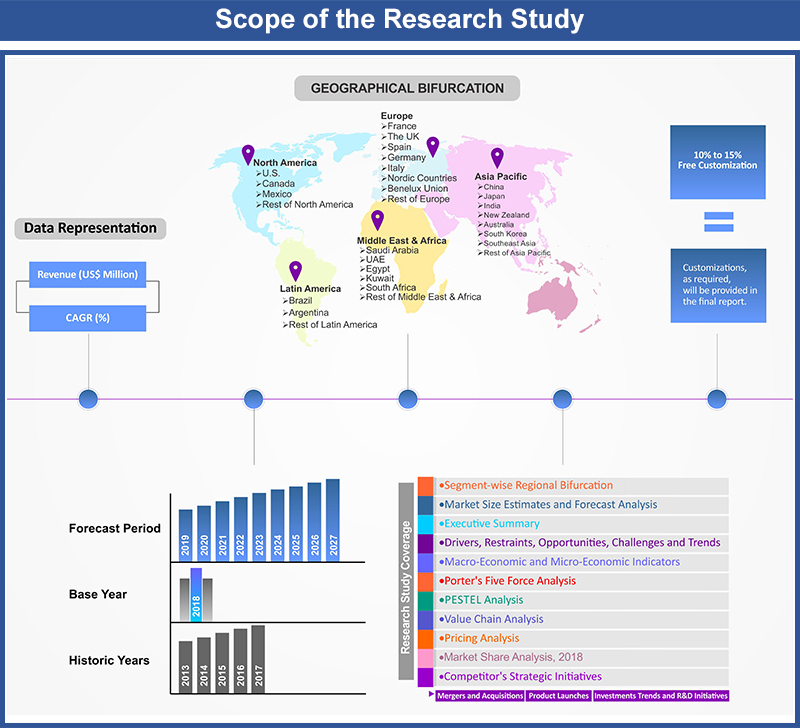Human Primary Cell Market By Type (Blood (peripheral) cells, Endothelial cells, Epithelial cells, Fibroblast cells, Hepatocyte cells, Keratinocyte cells, Melanocyte cells, Pancreatic cells, Smooth muscle cells, Skeletal cells, Adipocyte cells); By Application (Pharmaceutical, Biotechnology, Cosmetics, Academia); By Geography (North America, Europe, China, Japan, South-East Asia, India) ¬- Global Insights, Growth, Size, Comparative Analysis, Trends and Forecast, 2018 - 2026
Industry Trends
Human Primary cells are isolated from human tissues via enzymatic or mechanical method. These cells provide infrangible and usual experimental outcomes, as they are physiologically normal. Normal primary cells preserve almost all native cellular functions in vitro, such as morphology, growth characteristics, cellular makers, signaling and genetic integrity. Companies offering human primary cells are required to comply with ethical sourcing and related regulations prevalent in their operating regions.
Increasing usage of these primary cells in medical and clinical research, for the study of cell structure & functions and for drug development is positively impacting the Human Primary Cell Market growth. These cells have vital importance in areas such as cancer research, and studies related to various other chronic diseases. Moreover, cells such as fibroblasts, keratinocytes and Melanocytes are also used in the cosmetics industry for the testing for various cosmetic products. The developed regions are presently bigger markets for human primary cells with their exorbitantly high investments in medical research field. The demand in emerging economies is comparatively lesser, however, is expected to witness a notable growth in near future.
Human Primary Cell Market is expected to grow with a CAGR of 7% during the forecast period of 2017-2026. The study analyzes the market in terms of revenue and sales volume across all the major markets.
Asia Pacific, Human Primary Cell Sales, 2017 - 2026
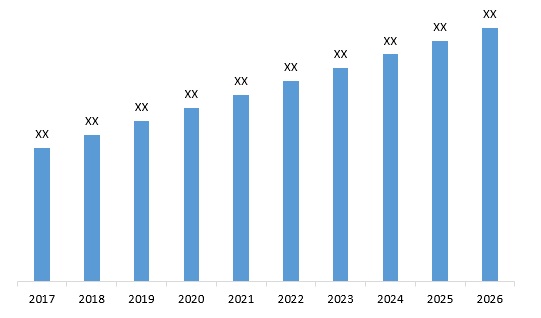
Competitive Landscape
The report provides both, qualitative and quantitative research of the market, as well as provides worthy insights into the rational scenario and favored development methods adopted by the key contenders. The Human Primary Cell Market report also offers extensive research on the key players in this market and detailed insights on the competitiveness of these players. The key business strategies such as mergers and acquisitions (M&A), affiliations, collaborations, and contracts adopted by the major players are also recognized and analyzed in the report. For each company, the report recognizes their headquarter, competitors, product type, application and specification, pricing, and gross margin.
Some of the players operating in the human primary cell market are Lonza, Thermo Fisher Scientific, Sigma-Aldrich, Cell Biologics, PromoCell GmbH, Cureline, Zen-Bio, Stemcell Technologies, Pelobiotech, among the others.
By Type
- Blood (peripheral) cells
- Endothelial cells
- Epithelial cells
- Fibroblast cells
- Hepatocyte cells
- Keratinocyte cells
- Melanocyte cells
- Pancreatic cells
- Smooth muscle cells
- Skeletal cells
- Adipocyte cells
By Application
- Pharmaceutical
- Biotechnology
- Cosmetics
- Academia
By Geography
- North America
- U.S.
- Rest of North America
- Europe
- France
- The UK
- Spain
- Germany
- Italy
- Rest of Europe
- Asia Pacific
- China
- Japan
- India
- Southeast Asia
- Rest of Asia Pacific
- Middle East and Africa
- GCC Countries
- Southern Africa
- Rest of Middle East and Africa
- Latin America
- Brazil
- Rest of Latin America
1. Introduction
1.1. Market Scope
1.2. Market Segmentation
1.3. Methodology
1.4. Assumptions
2. Human Primary Cell Market Snapshot
3. Executive Summary: Human Primary Cell Market
4. Qualitative Analysis: Human Primary Cell Market
4.1. Introduction
4.1.1. Product Definition
4.1.2. Industry Development
4.2. Market Dynamics
4.2.1. Drivers
4.2.2. Restraints
4.2.3. Opportunities
4.3. Trends in Human Primary Cell Market
5. Global Human Primary Cell Market Analysis and Forecasts, 2018
– 2026
5.1. Overview
5.1.1. Global Human Primary Cell Market Revenue (US$ Mn) and
Forecasts
5.2. Global Human Primary Cell Market Revenue (US$ Mn) and
Forecasts, By Type
5.2.1. Blood (peripheral) cells
5.2.1.1.
Definition
5.2.1.2.
Market Penetration
5.2.1.3.
Market Revenue Expected
to Increase by 2026
5.2.1.4. Compound Annual Growth Rate (CAGR)
5.2.2. Endothelial cells
5.2.2.1.
Definition
5.2.2.2.
Market Penetration
5.2.2.3.
Market Revenue Expected
to Increase by 2026
5.2.2.4. Compound Annual Growth Rate (CAGR)
5.2.3. Epithelial cells
5.2.3.1.
Definition
5.2.3.2.
Market Penetration
5.2.3.3.
Market Revenue Expected
to Increase by 2026
5.2.3.4. Compound Annual Growth Rate (CAGR)
5.2.4. Fibroblast cells
5.2.4.1.
Definition
5.2.4.2.
Market Penetration
5.2.4.3.
Market Revenue Expected
to Increase by 2026
5.2.4.4. Compound Annual Growth Rate (CAGR)
5.2.5. Hepatocyte cells
5.2.5.1.
Definition
5.2.5.2.
Market Penetration
5.2.5.3.
Market Revenue Expected
to Increase by 2026
5.2.5.4. Compound Annual Growth Rate (CAGR)
5.2.6. Keratinocyte cells
5.2.6.1.
Definition
5.2.6.2.
Market Penetration
5.2.6.3.
Market Revenue Expected
to Increase by 2026
5.2.6.4. Compound Annual Growth Rate (CAGR)
5.2.7. Melanocyte cells
5.2.7.1.
Definition
5.2.7.2.
Market Penetration
5.2.7.3.
Market Revenue Expected
to Increase by 2026
5.2.7.4. Compound Annual Growth Rate (CAGR)
5.2.8. Pancreatic cells
5.2.8.1.
Definition
5.2.8.2.
Market Penetration
5.2.8.3.
Market Revenue Expected
to Increase by 2026
5.2.8.4. Compound Annual Growth Rate (CAGR)
5.2.9. Smooth muscle cells
5.2.9.1.
Definition
5.2.9.2.
Market Penetration
5.2.9.3.
Market Revenue Expected
to Increase by 2026
5.2.9.4.
Compound Annual Growth
Rate (CAGR)
5.2.10. Skeletal cells
5.2.10.1. Definition
5.2.10.2. Market Penetration
5.2.10.3. Market Revenue Expected to Increase by 2026
5.2.10.4. Compound Annual Growth Rate (CAGR)
5.2.11. Adipocyte cells
5.2.11.1.
Definition
5.2.11.2.
Market Penetration
5.2.11.3.
Market Revenue Expected
to Increase by 2026
5.2.11.4. Compound Annual Growth Rate (CAGR)
5.3. Key Segment for Channeling Investments
5.3.1. By Type
6. Global Human Primary Cell Market Analysis and Forecasts, 2018
– 2026
6.1. Overview
6.2. Global Human Primary Cell Market Revenue (US$ Mn) and
Forecasts, By Application
6.2.1. Pharmaceutical
6.2.1.1.
Definition
6.2.1.2.
Market Penetration
6.2.1.3.
Market Revenue Expected
to Increase by 2026
6.2.1.4. Compound Annual Growth Rate (CAGR)
6.2.2. Biotechnology
6.2.2.1.
Definition
6.2.2.2.
Market Penetration
6.2.2.3.
Market Revenue Expected
to Increase by 2026
6.2.2.4. Compound Annual Growth Rate (CAGR)
6.2.3. Cosmetics
6.2.3.1.
Definition
6.2.3.2.
Market Penetration
6.2.3.3.
Market Revenue Expected
to Increase by 2026
6.2.3.4. Compound Annual Growth Rate (CAGR)
6.2.4. Academia
6.2.4.1. Definition
6.2.4.2. Market Penetration
6.2.4.3. Market Revenue Expected to Increase by 2026
6.2.4.4. Compound Annual Growth Rate (CAGR)
6.3. Key Segment for Channeling Investments
6.3.1. By Application
7. North America Human Primary Cell Market Analysis and
Forecasts, 2018 – 2026
7.1. Overview
7.1.1. North America Human Primary Cell Market Revenue (US$ Mn)
7.2. North America Human Primary Cell Market Revenue (US$ Mn) and
Forecasts, By Type
7.2.1. Blood (peripheral) cells
7.2.2. Endothelial cells
7.2.3. Epithelial cells
7.2.4. Fibroblast cells
7.2.5. Hepatocyte cells
7.2.6. Keratinocyte cells
7.2.7. Melanocyte cells
7.2.8. Pancreatic cells
7.2.9. Smooth muscle cells
7.2.10. Skeletal cells
7.2.11. Adipocyte cells
7.3. North America Human Primary Cell Market Revenue (US$ Mn) and
Forecasts, By Application
7.3.1. Pharmaceutical
7.3.2. Biotechnology
7.3.3. Cosmetics
7.3.4. Academia
7.4. North America Human Primary Cell Market Revenue (US$ Mn) and
Forecasts, By Country
7.4.1. U.S.
7.4.1.1. U.S. Human Primary Cell Market Revenue (US$ Mn) and Forecasts,
By Type
7.4.1.1.1. Blood (peripheral) cells
7.4.1.1.2. Endothelial cells
7.4.1.1.3. Epithelial cells
7.4.1.1.4. Fibroblast cells
7.4.1.1.5. Hepatocyte cells
7.4.1.1.6. Keratinocyte cells
7.4.1.1.7. Melanocyte cells
7.4.1.1.8. Pancreatic cells
7.4.1.1.9. Smooth muscle cells
7.4.1.1.10.Skeletal cells
7.4.1.1.11.Adipocyte cells
7.4.1.2. U.S. Human Primary Cell Market Revenue (US$ Mn) and Forecasts,
By Application
7.4.1.2.1. Pharmaceutical
7.4.1.2.2. Biotechnology
7.4.1.2.3. Cosmetics
7.4.1.2.4. Academia
7.4.2. Rest of North America
7.4.2.1. Rest of North America Human Primary Cell Market Revenue (US$
Mn) and Forecasts, By Type
7.4.2.1.1. Blood (peripheral) cells
7.4.2.1.2. Endothelial cells
7.4.2.1.3. Epithelial cells
7.4.2.1.4. Fibroblast cells
7.4.2.1.5. Hepatocyte cells
7.4.2.1.6. Keratinocyte cells
7.4.2.1.7. Melanocyte cells
7.4.2.1.8. Pancreatic cells
7.4.2.1.9. Smooth muscle cells
7.4.2.1.10.Skeletal cells
7.4.2.1.11.Adipocyte cells
7.4.2.2. Rest of North America Human Primary Cell Market Revenue (US$
Mn) and Forecasts, By Application
7.4.2.2.1.
Pharmaceutical
7.4.2.2.2.
Biotechnology
7.4.2.2.3.
Cosmetics
7.4.2.2.4.
Academia
7.5. Key Segment for Channeling Investments
7.5.1. By Country
7.5.2. By Type
7.5.3. By Application
8. Europe Human Primary Cell Market Analysis and Forecasts, 2018
– 2026
8.1. Overview
8.1.1. Europe Human Primary Cell Market Revenue (US$ Mn)
8.2. Europe Human Primary Cell Market Revenue (US$ Mn) and
Forecasts, By Type
8.2.1. Blood (peripheral) cells
8.2.2. Endothelial cells
8.2.3. Epithelial cells
8.2.4. Fibroblast cells
8.2.5. Hepatocyte cells
8.2.6. Keratinocyte cells
8.2.7. Melanocyte cells
8.2.8. Pancreatic cells
8.2.9. Smooth muscle cells
8.2.10. Skeletal cells
8.2.11. Adipocyte cells
8.3. Europe Human Primary Cell Market Revenue (US$ Mn) and
Forecasts, By Application
8.3.1. Pharmaceutical
8.3.2. Biotechnology
8.3.3. Cosmetics
8.3.4. Academia
8.4. Europe Human Primary Cell Market Revenue (US$ Mn) and
Forecasts, By Country
8.4.1. France
8.4.1.1. France Human Primary Cell Market Revenue (US$ Mn) and
Forecasts, By Type
8.4.1.1.1. Blood (peripheral) cells
8.4.1.1.2. Endothelial cells
8.4.1.1.3. Epithelial cells
8.4.1.1.4. Fibroblast cells
8.4.1.1.5. Hepatocyte cells
8.4.1.1.6. Keratinocyte cells
8.4.1.1.7. Melanocyte cells
8.4.1.1.8. Pancreatic cells
8.4.1.1.9. Smooth muscle cells
8.4.1.1.10.Skeletal cells
8.4.1.1.11.Adipocyte cells
8.4.1.2. France Human Primary Cell Market Revenue (US$ Mn) and
Forecasts, By Application
8.4.1.2.1. Pharmaceutical
8.4.1.2.2. Biotechnology
8.4.1.2.3. Cosmetics
8.4.1.2.4. Academia
8.4.2. The UK
8.4.2.1. The UK Human Primary Cell Market Revenue (US$ Mn) and
Forecasts, By Type
8.4.2.1.1. Blood (peripheral) cells
8.4.2.1.2. Endothelial cells
8.4.2.1.3. Epithelial cells
8.4.2.1.4. Fibroblast cells
8.4.2.1.5. Hepatocyte cells
8.4.2.1.6. Keratinocyte cells
8.4.2.1.7. Melanocyte cells
8.4.2.1.8. Pancreatic cells
8.4.2.1.9. Smooth muscle cells
8.4.2.1.10.Skeletal cells
8.4.2.1.11.Adipocyte cells
8.4.2.2. The UK Human Primary Cell Market Revenue (US$ Mn) and
Forecasts, By Application
8.4.2.2.1. Pharmaceutical
8.4.2.2.2. Biotechnology
8.4.2.2.3. Cosmetics
8.4.2.2.4. Academia
8.4.3. Spain
8.4.3.1. Spain Human Primary Cell Market Revenue (US$ Mn) and
Forecasts, By Type
8.4.3.1.1. Blood (peripheral) cells
8.4.3.1.2. Endothelial cells
8.4.3.1.3. Epithelial cells
8.4.3.1.4. Fibroblast cells
8.4.3.1.5. Hepatocyte cells
8.4.3.1.6. Keratinocyte cells
8.4.3.1.7. Melanocyte cells
8.4.3.1.8. Pancreatic cells
8.4.3.1.9. Smooth muscle cells
8.4.3.1.10.Skeletal cells
8.4.3.1.11.Adipocyte cells
8.4.3.2. Spain Human Primary Cell Market Revenue (US$ Mn) and
Forecasts, By Application
8.4.3.2.1. Pharmaceutical
8.4.3.2.2. Biotechnology
8.4.3.2.3. Cosmetics
8.4.3.2.4. Academia
8.4.4. Germany
8.4.4.1. Germany Human Primary Cell Market Revenue (US$ Mn) and
Forecasts, By Type
8.4.4.1.1. Blood (peripheral) cells
8.4.4.1.2. Endothelial cells
8.4.4.1.3. Epithelial cells
8.4.4.1.4. Fibroblast cells
8.4.4.1.5. Hepatocyte cells
8.4.4.1.6. Keratinocyte cells
8.4.4.1.7. Melanocyte cells
8.4.4.1.8. Pancreatic cells
8.4.4.1.9. Smooth muscle cells
8.4.4.1.10.Skeletal cells
8.4.4.1.11.Adipocyte cells
8.4.4.2. Germany Human Primary Cell Market Revenue (US$ Mn) and
Forecasts, By Application
8.4.4.2.1. Pharmaceutical
8.4.4.2.2. Biotechnology
8.4.4.2.3. Cosmetics
8.4.4.2.4. Academia
8.4.5. Italy
8.4.5.1. Italy Human Primary Cell Market Revenue (US$ Mn) and
Forecasts, By Type
8.4.5.1.1. Blood (peripheral) cells
8.4.5.1.2. Endothelial cells
8.4.5.1.3. Epithelial cells
8.4.5.1.4. Fibroblast cells
8.4.5.1.5. Hepatocyte cells
8.4.5.1.6. Keratinocyte cells
8.4.5.1.7. Melanocyte cells
8.4.5.1.8. Pancreatic cells
8.4.5.1.9. Smooth muscle cells
8.4.5.1.10.Skeletal cells
8.4.5.1.11.Adipocyte cells
8.4.5.2. Italy Human Primary Cell Market Revenue (US$ Mn) and
Forecasts, By Application
8.4.5.2.1. Pharmaceutical
8.4.5.2.2. Biotechnology
8.4.5.2.3. Cosmetics
8.4.5.2.4.
Academia
8.4.6. Rest of Europe
8.4.6.1. Rest of Europe Human Primary Cell Market Revenue (US$ Mn) and
Forecasts, By Type
8.4.6.1.1. Blood (peripheral) cells
8.4.6.1.2. Endothelial cells
8.4.6.1.3. Epithelial cells
8.4.6.1.4. Fibroblast cells
8.4.6.1.5. Hepatocyte cells
8.4.6.1.6. Keratinocyte cells
8.4.6.1.7. Melanocyte cells
8.4.6.1.8. Pancreatic cells
8.4.6.1.9. Smooth muscle cells
8.4.6.1.10.Skeletal cells
8.4.6.1.11.Adipocyte cells
8.4.6.2. Rest of Europe Human Primary Cell Market Revenue (US$ Mn) and
Forecasts, By Application
8.4.6.2.1.
Pharmaceutical
8.4.6.2.2.
Biotechnology
8.4.6.2.3.
Cosmetics
8.4.6.2.4.
Academia
8.5. Key Segment for Channeling Investments
8.5.1.
By Country
8.5.2.
By Type
8.5.3.
By Application
9. Asia Pacific Human
Primary Cell Market Analysis and Forecasts, 2018 – 2026
9.1. Overview
9.1.1. Asia Pacific Human Primary Cell Market Revenue (US$ Mn)
9.2. Asia Pacific Human Primary Cell Market Revenue (US$ Mn) and
Forecasts, By Type
9.2.1.
Blood (peripheral) cells
9.2.2.
Endothelial cells
9.2.3.
Epithelial cells
9.2.4.
Fibroblast cells
9.2.5.
Hepatocyte cells
9.2.6.
Keratinocyte cells
9.2.7.
Melanocyte cells
9.2.8.
Pancreatic cells
9.2.9.
Smooth muscle cells
9.2.10.
Skeletal cells
9.2.11.
Adipocyte cells
9.3. Asia Pacific Human Primary Cell Market Revenue (US$ Mn) and
Forecasts, By Application
9.3.1. Pharmaceutical
9.3.2. Biotechnology
9.3.3. Cosmetics
9.3.4. Academia
9.4. Asia Pacific Human Primary Cell Market Revenue (US$ Mn) and
Forecasts, By Country
9.4.1. China
9.4.1.1. China Human Primary Cell Market Revenue (US$ Mn) and
Forecasts, By Type
9.4.1.1.1. Blood (peripheral) cells
9.4.1.1.2. Endothelial cells
9.4.1.1.3. Epithelial cells
9.4.1.1.4. Fibroblast cells
9.4.1.1.5. Hepatocyte cells
9.4.1.1.6. Keratinocyte cells
9.4.1.1.7. Melanocyte cells
9.4.1.1.8. Pancreatic cells
9.4.1.1.9. Smooth muscle cells
9.4.1.1.10.Skeletal cells
9.4.1.1.11.Adipocyte cells
9.4.1.2. China Human Primary Cell Market Revenue (US$ Mn) and
Forecasts, By Application
9.4.1.2.1. Pharmaceutical
9.4.1.2.2. Biotechnology
9.4.1.2.3. Cosmetics
9.4.1.2.4. Academia
9.4.2. Japan
9.4.2.1. Japan Human Primary Cell Market Revenue (US$ Mn) and
Forecasts, By Type
9.4.2.1.1. Blood (peripheral) cells
9.4.2.1.2. Endothelial cells
9.4.2.1.3. Epithelial cells
9.4.2.1.4. Fibroblast cells
9.4.2.1.5. Hepatocyte cells
9.4.2.1.6. Keratinocyte cells
9.4.2.1.7. Melanocyte cells
9.4.2.1.8. Pancreatic cells
9.4.2.1.9. Smooth muscle cells
9.4.2.1.10.Skeletal cells
9.4.2.1.11.Adipocyte cells
9.4.2.2. Japan Human Primary Cell Market Revenue (US$ Mn) and
Forecasts, By Application
9.4.2.2.1. Pharmaceutical
9.4.2.2.2. Biotechnology
9.4.2.2.3. Cosmetics
9.4.2.2.4. Academia
9.4.3. India
9.4.3.1. India Human Primary Cell Market Revenue (US$ Mn) and
Forecasts, By Type
9.4.3.1.1. Blood (peripheral) cells
9.4.3.1.2. Endothelial cells
9.4.3.1.3. Epithelial cells
9.4.3.1.4. Fibroblast cells
9.4.3.1.5. Hepatocyte cells
9.4.3.1.6. Keratinocyte cells
9.4.3.1.7. Melanocyte cells
9.4.3.1.8. Pancreatic cells
9.4.3.1.9. Smooth muscle cells
9.4.3.1.10.Skeletal cells
9.4.3.1.11.Adipocyte cells
9.4.3.2. India Human Primary Cell Market Revenue (US$ Mn) and
Forecasts, By Application
9.4.3.2.1. Pharmaceutical
9.4.3.2.2. Biotechnology
9.4.3.2.3. Cosmetics
9.4.3.2.4. Academia
9.4.4. Southeast Asia
9.4.4.1. Southeast Asia Human Primary Cell Market Revenue (US$ Mn) and
Forecasts, By Type
9.4.4.1.1. Blood (peripheral) cells
9.4.4.1.2. Endothelial cells
9.4.4.1.3. Epithelial cells
9.4.4.1.4. Fibroblast cells
9.4.4.1.5. Hepatocyte cells
9.4.4.1.6. Keratinocyte cells
9.4.4.1.7. Melanocyte cells
9.4.4.1.8. Pancreatic cells
9.4.4.1.9. Smooth muscle cells
9.4.4.1.10.Skeletal cells
9.4.4.1.11.Adipocyte cells
9.4.4.2. Southeast Asia Human Primary Cell Market Revenue (US$ Mn) and
Forecasts, By Application
9.4.4.2.1. Pharmaceutical
9.4.4.2.2. Biotechnology
9.4.4.2.3. Cosmetics
9.4.4.2.4. Academia
9.4.5. Rest of Asia Pacific
9.4.5.1. Rest of Asia Pacific Human Primary Cell Market Revenue (US$
Mn) and Forecasts, By Type
9.4.5.1.1. Blood (peripheral) cells
9.4.5.1.2. Endothelial cells
9.4.5.1.3. Epithelial cells
9.4.5.1.4. Fibroblast cells
9.4.5.1.5. Hepatocyte cells
9.4.5.1.6. Keratinocyte cells
9.4.5.1.7. Melanocyte cells
9.4.5.1.8. Pancreatic cells
9.4.5.1.9. Smooth muscle cells
9.4.5.1.10.Skeletal cells
9.4.5.1.11.Adipocyte cells
9.4.5.2. Rest of Asia Pacific Human Primary Cell Market Revenue (US$
Mn) and Forecasts, By Application
9.4.5.2.1.
Pharmaceutical
9.4.5.2.2.
Biotechnology
9.4.5.2.3.
Cosmetics
9.4.5.2.4.
Academia
9.5. Key Segment for Channeling Investments
9.5.1. By Country
9.5.2. By Type
9.5.3. By Application
10. Middle East and Africa
Human Primary Cell Market Analysis and Forecasts, 2018 – 2026
10.1. Overview
10.1.1. Middle East and Africa Human Primary Cell Market Revenue (US$
Mn)
10.2. Middle East and Africa Human Primary Cell Market Revenue (US$
Mn) and Forecasts, By Type
10.2.1. Blood (peripheral) cells
10.2.2. Endothelial cells
10.2.3. Epithelial cells
10.2.4. Fibroblast cells
10.2.5. Hepatocyte cells
10.2.6. Keratinocyte cells
10.2.7. Melanocyte cells
10.2.8. Pancreatic cells
10.2.9. Smooth muscle cells
10.2.10. Skeletal cells
10.2.11. Adipocyte cells
10.3. Middle East and Africa Human Primary Cell Market Revenue (US$
Mn) and Forecasts, By Application
10.3.1. Pharmaceutical
10.3.2. Biotechnology
10.3.3. Cosmetics
10.3.4. Academia
10.4. Middle East and Africa Human Primary Cell Market Revenue (US$
Mn) and Forecasts, By Country
10.4.1. GCC Countries
10.4.1.1. GCC Countries Human Primary Cell Market Revenue (US$ Mn) and
Forecasts, By Type
10.4.1.1.1. Blood (peripheral) cells
10.4.1.1.2. Endothelial cells
10.4.1.1.3. Epithelial cells
10.4.1.1.4. Fibroblast cells
10.4.1.1.5. Hepatocyte cells
10.4.1.1.6. Keratinocyte cells
10.4.1.1.7. Melanocyte cells
10.4.1.1.8. Pancreatic cells
10.4.1.1.9. Smooth muscle cells
10.4.1.1.10. Skeletal cells
10.4.1.1.11. Adipocyte cells
10.4.1.2. GCC Countries Human Primary Cell Market Revenue (US$ Mn) and
Forecasts, By Application
10.4.1.2.1. Pharmaceutical
10.4.1.2.2. Biotechnology
10.4.1.2.3. Cosmetics
10.4.1.2.4. Academia
10.4.2. Southern Africa
10.4.2.1. Southern Africa Human Primary Cell Market Revenue (US$ Mn) and
Forecasts, By Type
10.4.2.1.1. Blood (peripheral) cells
10.4.2.1.2. Endothelial cells
10.4.2.1.3. Epithelial cells
10.4.2.1.4. Fibroblast cells
10.4.2.1.5. Hepatocyte cells
10.4.2.1.6. Keratinocyte cells
10.4.2.1.7. Melanocyte cells
10.4.2.1.8. Pancreatic cells
10.4.2.1.9. Smooth muscle cells
10.4.2.1.10. Skeletal cells
10.4.2.1.11. Adipocyte cells
10.4.2.2. Southern Africa Human Primary Cell Market Revenue (US$ Mn) and
Forecasts, By Application
10.4.2.2.1. Pharmaceutical
10.4.2.2.2. Biotechnology
10.4.2.2.3. Cosmetics
10.4.2.2.4. Academia
10.4.3. Rest of MEA
10.4.3.1. Rest of MEA Human Primary Cell Market Revenue (US$ Mn) and
Forecasts, By Type
10.4.3.1.1. Blood (peripheral) cells
10.4.3.1.2. Endothelial cells
10.4.3.1.3. Epithelial cells
10.4.3.1.4. Fibroblast cells
10.4.3.1.5. Hepatocyte cells
10.4.3.1.6. Keratinocyte cells
10.4.3.1.7. Melanocyte cells
10.4.3.1.8. Pancreatic cells
10.4.3.1.9. Smooth muscle cells
10.4.3.1.10.
Skeletal cells
10.4.3.1.11.
Adipocyte cells
10.4.3.2. Rest of MEA Human Primary Cell Market Revenue (US$ Mn) and
Forecasts, By Application
10.4.3.2.1. Pharmaceutical
10.4.3.2.2. Biotechnology
10.4.3.2.3. Cosmetics
10.4.3.2.4. Academia
10.5. Key Segment for Channeling Investments
10.5.1. By Country
10.5.2. By Type
10.5.3. By Application
11. Latin America Human Primary Cell Market Analysis and
Forecasts, 2018 – 2026
11.1. Overview
11.1.1. Latin America Human Primary Cell Market Revenue (US$ Mn)
11.2. Latin America Human Primary Cell Market Revenue (US$ Mn) and
Forecasts, By Type
11.2.1. Blood (peripheral) cells
11.2.2. Endothelial cells
11.2.3. Epithelial cells
11.2.4. Fibroblast cells
11.2.5. Hepatocyte cells
11.2.6. Keratinocyte cells
11.2.7. Melanocyte cells
11.2.8. Pancreatic cells
11.2.9. Smooth muscle cells
11.2.10. Skeletal cells
11.2.11. Adipocyte cells
11.3. Latin America Human Primary Cell Market Revenue (US$ Mn) and
Forecasts, By Application
11.3.1. Pharmaceutical
11.3.2. Biotechnology
11.3.3. Cosmetics
11.3.4. Academia
11.4. Latin America Human Primary Cell Market Revenue (US$ Mn) and
Forecasts, By Country
11.4.1. Brazil
11.4.1.1. Brazil Human Primary Cell Market Revenue (US$ Mn) and
Forecasts, By Type
11.4.1.1.1. Blood (peripheral) cells
11.4.1.1.2. Endothelial cells
11.4.1.1.3. Epithelial cells
11.4.1.1.4. Fibroblast cells
11.4.1.1.5. Hepatocyte cells
11.4.1.1.6. Keratinocyte cells
11.4.1.1.7. Melanocyte cells
11.4.1.1.8. Pancreatic cells
11.4.1.1.9. Smooth muscle cells
11.4.1.1.10.
Skeletal cells
11.4.1.1.11.
Adipocyte cells
11.4.1.2. Brazil Human Primary Cell Market Revenue (US$ Mn) and
Forecasts, By Application
11.4.1.2.1. Pharmaceutical
11.4.1.2.2. Biotechnology
11.4.1.2.3. Cosmetics
11.4.1.2.4. Academia
11.4.2. Rest of Latin America
11.4.2.1. Rest of Latin America Human Primary Cell Market Revenue (US$
Mn) and Forecasts, By Type
11.4.2.1.1. Blood (peripheral) cells
11.4.2.1.2. Endothelial cells
11.4.2.1.3. Epithelial cells
11.4.2.1.4. Fibroblast cells
11.4.2.1.5. Hepatocyte cells
11.4.2.1.6. Keratinocyte cells
11.4.2.1.7. Melanocyte cells
11.4.2.1.8. Pancreatic cells
11.4.2.1.9. Smooth muscle cells
11.4.2.1.10.
Skeletal cells
11.4.2.1.11.
Adipocyte cells
11.4.2.2. Rest of Latin America Human Primary Cell Market Revenue (US$
Mn) and Forecasts, By Application
11.4.2.2.1. Pharmaceutical
11.4.2.2.2. Biotechnology
11.4.2.2.3. Cosmetics
11.4.2.2.4. Academia
11.5. Key Segment for Channeling Investments
11.5.1. By Country
11.5.2. By Type
11.5.3. By Application
12. Competitive Benchmarking
12.1. Player Positioning Analysis
12.2. Global Presence and Growth Strategies
13. Player Profiles
13.1. Cell Biologics
13.1.1. Company Details
13.1.2. Company Overview
13.1.3. Product Offerings
13.1.4. Key Developments
13.1.5. Financial Analysis
13.1.6. SWOT Analysis
13.1.7. Business Strategies
13.2. Cureline
13.2.1. Company Details
13.2.2. Company Overview
13.2.3. Product Offerings
13.2.4. Key Developments
13.2.5. Financial Analysis
13.2.6. SWOT Analysis
13.2.7. Business Strategies
13.3. Lonza
13.3.1. Company Details
13.3.2. Company Overview
13.3.3. Product Offerings
13.3.4. Key Developments
13.3.5. Financial Analysis
13.3.6. SWOT Analysis
13.3.7. Business Strategies
13.4. Pelobiotech
13.4.1. Company Details
13.4.2. Company Overview
13.4.3. Product Offerings
13.4.4. Key Developments
13.4.5. Financial Analysis
13.4.6. SWOT Analysis
13.4.7. Business Strategies
13.5. PromoCell GmbH
13.5.1. Company Details
13.5.2. Company Overview
13.5.3. Product Offerings
13.5.4. Key Developments
13.5.5. Financial Analysis
13.5.6. SWOT Analysis
13.5.7. Business Strategies
13.6. Sigma-Aldrich
13.6.1. Company Details
13.6.2. Company Overview
13.6.3. Product Offerings
13.6.4. Key Developments
13.6.5. Financial Analysis
13.6.6. SWOT Analysis
13.6.7. Business Strategies
13.7. Stemcell Technologies
13.7.1. Company Details
13.7.2. Company Overview
13.7.3. Product Offerings
13.7.4. Key Developments
13.7.5. Financial Analysis
13.7.6. SWOT Analysis
13.7.7. Business Strategies
13.8. Thermo Fisher Scientific
13.8.1. Company Details
13.8.2. Company Overview
13.8.3. Product Offerings
13.8.4. Key Developments
13.8.5. Financial Analysis
13.8.6. SWOT Analysis
13.8.7. Business Strategies
13.9. Zen-Bio
13.9.1. Company Details
13.9.2. Company Overview
13.9.3. Product Offerings
13.9.4. Key Developments
13.9.5. Financial Analysis
13.9.6. SWOT Analysis
13.9.7. Business Strategies
At Absolute Markets Insights, we are engaged in building both global as well as country specific reports. As a result, the approach taken for deriving the estimation and forecast for a specific country is a bit unique and different in comparison to the global research studies. In this case, we not only study the concerned market factors & trends prevailing in a particular country (from secondary research) but we also tend to calculate the actual market size & forecast from the revenue generated from the market participants involved in manufacturing or distributing the any concerned product. These companies can also be service providers. For analyzing any country specifically, we do consider the growth factors prevailing under the states/cities/county for the same. For instance, if we are analyzing an industry specific to United States, we primarily need to study about the states present under the same(where the product/service has the highest growth). Similar analysis will be followed by other countries. Our scope of the report changes with different markets.
Our research study is mainly implement through a mix of both secondary and primary research. Various sources such as industry magazines, trade journals, and government websites and trade associations are reviewed for gathering precise data. Primary interviews are conducted to validate the market size derived from secondary research. Industry experts, major manufacturers and distributors are contacted for further validation purpose on the current market penetration and growth trends.
Prominent participants in our primary research process include:
- Key Opinion Leaders namely the CEOs, CSOs, VPs, purchasing managers, amongst others
- Research and development participants, distributors/suppliers and subject matter experts
Secondary Research includes data extracted from paid data sources:
- Reuters
- Factiva
- Bloomberg
- One Source
- Hoovers
Research Methodology
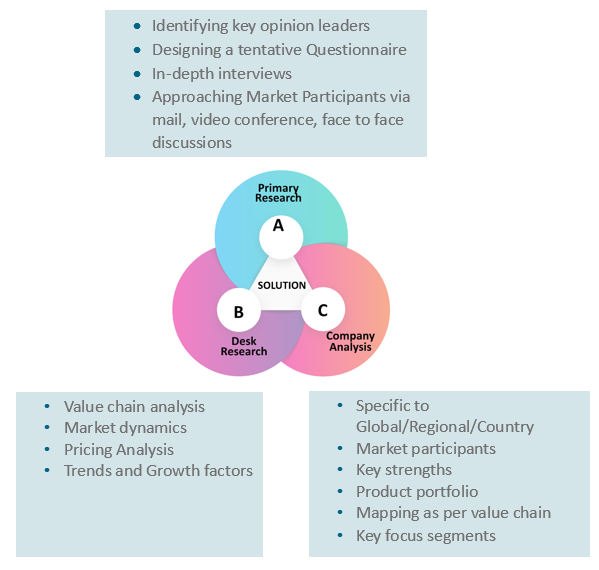
Key Inclusions
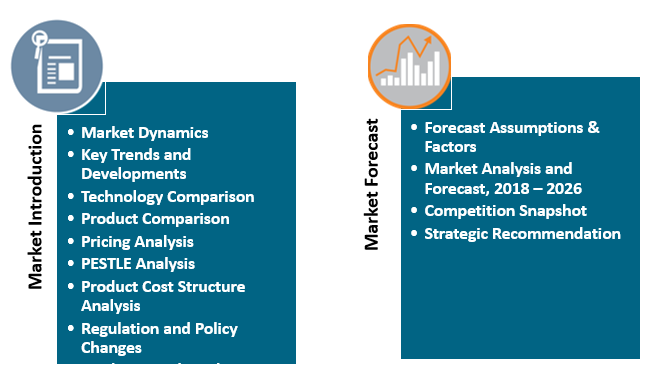
Reach to us
Call us on
+91-74002-42424
Drop us an email at
sales@absolutemarketsinsights.com
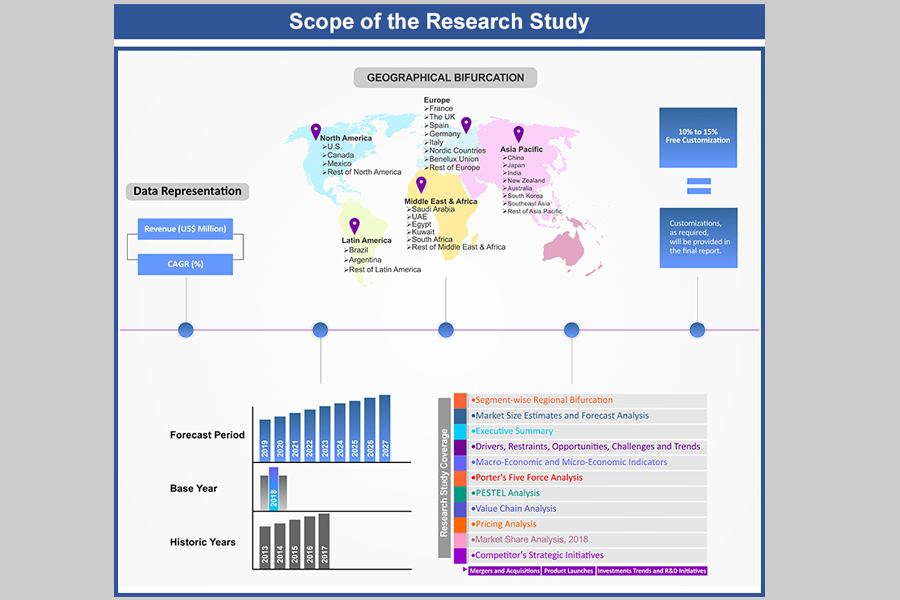
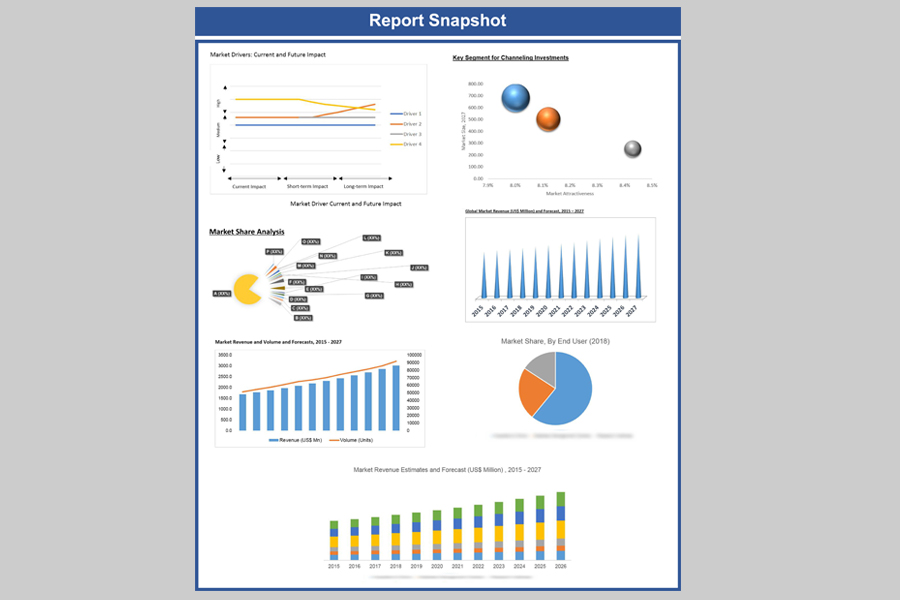
Why Absolute Markets Insights?
An effective strategy is the entity that influences a business to stand out of the crowd. An organization with a phenomenal strategy for success dependably has the edge over the rivals in the market. It offers the organizations a head start in planning their strategy. Absolute Market Insights is the new initiation in the industry that will furnish you with the lead your business needs. Absolute Market Insights is the best destination for your business intelligence and analytical solutions; essentially because our qualitative and quantitative sources of information are competent to give one-stop solutions. We inventively combine qualitative and quantitative research in accurate proportions to have the best report, which not only gives the most recent insights but also assists you to grow.


